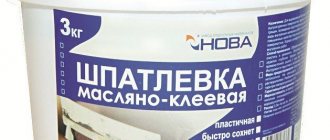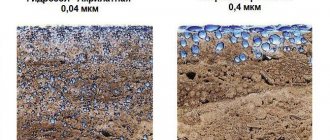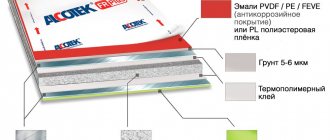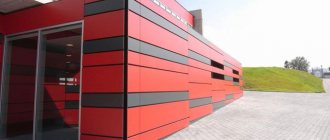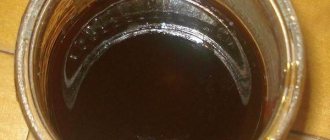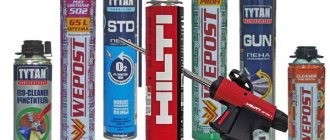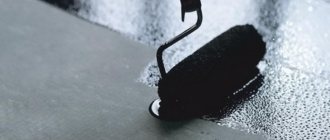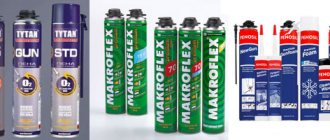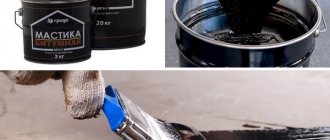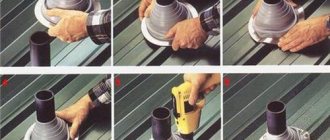Currently, Macroflex 750 is widely used in construction and repair - a sealing sealant, which is a one-component foam (consisting of polyurethane) that hardens in air.
This article describes the characteristics of polyurethane foam, provides technical parameters, and provides recommendations for the correct use of the material.
Polyurethane foam
Pros and cons of Macroflex foam
Macroflex foam is a one-component composition that is completely ready for use; it does not need to be mixed or diluted. Thanks to the packaging in the form of a tube, the foam is very convenient to apply - all you need to do is purchase a suitable mounting gun.
To work, you don’t have to carry heavy bags, buy expensive tools and equipment, waste electricity, water, or stir up dust and dirt. The absence of the need to mix mortar seriously reduces time costs and helps carry out construction and repairs much faster.
Other properties and advantages of the composition are as follows:
- high strength of any joints (no less than standard cement mortars);
- the ability to replace dry building mixtures in many situations;
- effective joining of homogeneous and dissimilar building materials;
- suitability for working with both horizontal and vertical surfaces indoors and outdoors;
- reliable sealing and insulation of seams from moisture and minimization of heat loss;
- short time until complete hardening;
- ability to withstand heat and freezing;
- the ability to carry out work at sub-zero temperatures;
- control of foam consumption thanks to a special packaging design;
- absence of chlorofluorocarbon propellants in the composition;
- low price and low cost of work.
Foam-cement "Macroflex" effectively glues, seals, seals cracks, strengthens and provides moisture, sound, and thermal insulation of structures, so it can be called a universal building material.
Despite the impressive list of advantages, foam also has disadvantages. “Macroflex” is a composition that, after hardening, is prone to shrinkage. However, due to the strong expansion after setting, most often such shrinkage remains unnoticeable.
Under the influence of ultraviolet radiation, the foam gradually collapses, but this disadvantage can be smoothed out by protecting its top layer with mortars, putties, and sealants. "Macroflex" cannot be used for installing load-bearing walls - the composition is only suitable for lighter structures.
Range
For every consumer there is a product made from the Makroflex line:
- Makroflex Premium is a premium product that has increased pressure in the cylinder for quick foam release.
- Makroflex PRO 65 professional - foam comes out in increased volumes and standard.
- Macroflex special installation compounds: 2x2 - all-season, FR77 - fire-resistant, 2K 8MIN, Siberian 65 PRO - winter, foam-cement - construction;
- Makroflex White is a one-component white composition.
Adhesive cement
The name “glue-cement” can hide several varieties of products. Cement-based tile adhesive (or cement glue) in the form of a dry mixture, which is sold in bags. Dry glue, when combined with water, forms a plastic solution, characterized by high adhesion and ease of use. With the help of tile adhesive, it is possible to tiling with tiles from various materials and perform other construction and finishing work. Cement adhesive is suitable for fixing materials on horizontal and vertical surfaces. It is first necessary to clean the base from dirt and dust. The cement-based mixture hardens quickly and does not shrink, which makes it widely used in construction and finishing work in rooms of various functions. But cement adhesive requires work to prepare the mixture, so the composition should not be considered as an alternative. But polyurethane adhesive cement is produced in aerosol cans. The work is done quickly, cleanly and conveniently.
Description
Adhesive cement is a polyurethane one-component composition, fast hardening, non-expanding, high-performance, replaces cement and cement-adhesive mixtures. Available in metal aerosol cans. Does not require time and effort to prepare the solution. Adhesive cement is characterized by its economical use, simplicity and convenience of use, high speed of work, eliminates cold bridges, application is carried out using a special gun. Resistant to moisture, mildew and aging. It is a good alternative to traditional cement masonry mortars.
MASTERTEKS PM professional mounting adhesive cement for blocks 870 ml. Photo by Maxidom
Characteristics
The characteristics differ depending on the manufacturer, but it is possible to note the general ones:
- purpose - building material;
- method of application - professional, i.e. using a pistol;
- type according to seasonality - all-season;
- for interior work - yes;
- for outdoor work - yes;
- lack of secondary expansion;
- wide operating temperature range;
- high adhesion to various existing building materials;
- hardening is carried out under the influence of moisture from the air;
- no harm to the ozone layer;
- gray or light gray color.
For tiles and more
Adhesive cement is intended for laying partition walls made of gas and foam concrete, polystyrene concrete blocks, expanded clay concrete, tongue-and-groove and cement-fiber slabs, silicate and ceramic bricks. It is important to remember that the composition is not suitable for forming load-bearing walls. Performs gluing on concrete, wood, brick, metal, polymer artificial materials, etc., fixing cellular and heterogeneous materials, insulating panels to foundations and facades.
Manufacturers
Adhesive cement is produced under several brands. You can find products from TECHNONICOL, Kolt, Master Teks, etc. on sale. Each manufacturer offers its own recommendations for use and provides information about the main characteristics and features. The list of brands is not so extensive, so when choosing, you should pay special attention to other factors.
Criterias of choice
One of the main parameters is the characteristics of the base. Despite the possibility of successfully working with many materials, you should carefully study the instructions for use. Many manufacturers indicate types of substrates that are not recommended to work with using adhesive cement of certain brands. When choosing an adhesive, it is also necessary to take into account the parameters of the material from which the masonry is made. In addition, when choosing, you need to remember the main technical characteristics, the indicators of which differ from one manufacturer to another.
Consumer Reviews
Most craftsmen advise choosing polyurethane foam from the manufacturer Makroflex, because it has many positive customer reviews, which are based on the advantages of the mixture:
- Reasonable price.
- Short hardening time.
- Practical and easy to use.
- Large scope of application.
- Durability and reliability.
- Large range of products.
Like any building materials, polyurethane foam has negative reviews from customers. Mostly they come from those who used the mixture not according to the instructions, and did not follow the safety rules when using foam. You will learn about the advantages and disadvantages of polyurethane foam in the following video.
Useful tips and tricks
Before using MACROFLEX foam cement, the surfaces to be bonded should be thoroughly cleaned of any contaminants and degreased in one way or another. Before direct use, if possible, foam containers are kept at a temperature of 20-23 degrees Celsius for 12 hours and shaken vigorously with sharp movements at least 20 times.
The gun can be removed from the cylinder only after the cylinder is completely empty, after which its applicator is immediately washed with Premium Cleaner. Or, if the installation and construction work is not completed, it is replaced as quickly as possible with a fresh container of MACROFLEX foam cement
Precautionary measures
The cylinder is filled with gas that comes out along with the polyurethane. Additionally, butane and carbon dioxide are released during polymerization. Work must be carried out in a ventilated area.
Gas is flammable. The presence of open sources of fire is unacceptable. It is prohibited to heat cylinders with burners or throw them into a fire.
Work is performed only in special clothing. Sticky foam is difficult and painful to remove from the body. Be sure to cover objects located near the work. Adhered foam is removed with special solvents or folk remedies are used: vegetable oil, Dimexide, salt solution.
After foaming, do not rush to cut off the cap. If you have extra time, it is better to wait. It is not possible to accurately determine the final polymerization period. Premature removal of excess will ruin the entire job.
Characteristics and properties
Macroflex is in fact a liquid polyurethane that hardens when combined with moisture from the air. Technical characteristics are standard for similar products. The consumption of the mixture depends on the weather conditions, but is considered to be the minimum possible. Macroflex polyurethane foam is characterized by the following data:
- Expansion – 2 times (error – 5%);
- Curing time – 1 hour;
- Density – 25-35 kg per cubic meter. meter;
- Fire resistance – B3 (according to DIN 4102);
- Compressive and tensile strength – 3 n/cub. cm for one-component and 5 n/cub. cm - for a two-component composition.
Premium series foam is more flexible and durable than standard foam.
Foam Macroflex Pro
The foam hardens under the influence of air humidity, is easy to use and safe. There is a slight smell, but it disappears quickly.
At air temperature + 20 degrees. and humidity not less than 30%, hardening time - 15 minutes. In 100% humidity this takes an hour. Under difficult conditions, complete hardening occurs within a day. Resistance to temperatures – ranging from – 55 to +90 degrees.
No less important information on the topic: Service life of polyurethane foam
The material is not flammable; melting requires temperatures above 400 degrees. Recommended shelf life in packaging is 15 months.
Macroflex White Technology
Macroflex White Technology is free from most of the disadvantages of other types. This new generation of foam is created on the basis of polymers with high purity and a fine-porous structure with four times more cells. Pure polymer guarantees proper hardening, snow-white color, cellular structure with great strength and elasticity. She is immune to ultraviolet radiation. The hardened foam provides high thermal and sound insulation characteristics. White Technology is characterized by low expansion pressure, which provides ease of installation and compensates for seam movements - over 25%. Due to its thermoplasticity, it guarantees long-lasting insulation and sealing.
ShakeTec technology is implemented - a metal ball inserted inside the cylinder improves the mixability of the components when shaken. The cylinder is equipped with a new valve that preserves the properties of the product. Contains no freons.
Soudal
Special mention should be made of the super-frost-resistant foam from Soudal. Which successfully promotes its product to the Russian market, since such sealant is in demand in cold conditions. The unique characteristics of “Soudal”, with the help of which construction and installation works are carried out, replacement of windows and doors at temperatures down to minus 25 ° C.
This material is durable, resistant to stretching and compression. The adhesive properties of foam to basic materials (stone, metal, concrete and wood) even at extremely low temperatures meet European requirements. This type of sealant is fire-resistant, and in terms of other characteristics Soudal twice exceeds the requirements for similar materials that exist today.
Advantages and disadvantages of Makroflex
The difference between this mixture and the usual polyurethane foam in cylinders is that it can be used as polyurethane foam adhesive for aerated concrete blocks.
Cement brand M500: how to choose and characteristics
How does it differ from other fastening compounds?
- Compared to other foams, cement foam does not expand much and shrinks slightly - which is especially important for strong masonry.
- In masonry on foam-cement, thin joints (1-2 mm) can be made, through which less heat is lost. For comparison: a seam made of cement-sand mortar is at least 10 mm.
- Liquid cement in cans is more expensive than cement mortar, but it also consumes less.
- To work, you do not need to dilute the solution; the work takes place without dust, dirt and almost effortlessly. And bringing cylinders to the site is easier than carrying bags of cement.
- You can work where there is no water or electricity.
- It dries faster than cement, so work takes less time.
- Allows you to work in fairly cold weather.
- Allows you to work indoors - it does not have a pungent odor, after hardening it completely evaporates.
- Foam cement is universal, it can be introduced into hard-to-reach places, onto vertical surfaces and applied to almost any material.
Macroflex foam cement also has some disadvantages:
- due to its slight expansion, it is not consumed as economically as other polyurethane foams;
- under the influence of sunlight it is destroyed;
- This is a chemically hazardous composition for the eyes, skin, and respiratory organs.
Regarding the last point: if you follow safety precautions (which is generally important during any construction work), then you will not face any negative effects from spraying a toxic substance. And to protect the foam from ultraviolet radiation, it is enough to cover it with paint, putty or plaster.
Calculation formula
The calculation formula includes data on dimensions and seam configuration. If the seam is rectangular, then the formula is used for calculation: P = W * D, where P is the flow rate, ml/1m.p of the seam; W – its width, mm; G – its depth, mm.
For example, for a seam with the same depth and width of 10 mm, the consumption will be 100 ml per 1 m.p. seam
But there are triangular seams, so the formula changes: P = 0.5 * W * D
To apply this, you need to cut the tip at 45 degrees.
Technical description
Foam cement in the Macroflex line is a ready-to-use one-component composition based on polyurethane. Technically, the material was developed as an alternative to cement mortar for masonry work and filling construction joints. According to the manufacturer, liquid concrete in a 0.85 liter cylinder (there are liter containers) can be replaced by a bag of PC 22.5 (M400) cement weighing 25 kg.
Considering the composition, it is worth noting that it meets one of the international requirements for construction aerosols - the absence of propellants in the composition. These are compounds that include molecules of chlorine, fluorine and carbon. Thanks to this, the blown mass practically does not emit unpleasant aromas, and after drying it does not smell at all.
| Parameter | Meaning |
| Density | 20 kg/cub.m |
| Water absorption | 1%/day, up to 10%/month |
| Noise insulation | Up to 60 dB |
| Coefficient of thermal conductivity | About 0.37-0.4 W/m*K |
| Formation of a surface film (crust) | 5-10 minutes |
| Hardening | 25-30 minutes |
| Shrinkage | Within 5% |
| Storage conditions for closed containers | +5-+30 degrees Celsius |
| Working temperature | -5-+35 degrees Celsius (optimal conditions within +21-025 degrees) |
| Operating temperature | -40-+90 degrees Celsius |
| Increase in volume upon contact with oxygen | Within 100% (2 times) |
| Extreme heating of solid mass | Short-term jumps up to +110 degrees Celsius |
| Filled seam width | Up to 50 mm |
| Consumption when performing masonry work | Foam concrete in cylinders for a gun 850 ml per 10-12 sq.m |
This is what the maximum tensile strength looks like when working with a particular material in compliance with the technological process of gluing the bases (in MPa):
- wood, polycarbonate, some plastics – 2 (close to the tensile strength of cement when working with natural stone);
- plastic (ABS, PVC) – 1 (an analogy can be drawn with the strength of contact between cement plaster or glue with a concrete surface);
- concrete, glass and ceramics, OSB – 0.3-1;
- bitumens and materials based on them, foam plastics - 0.2-0.25 (this is comparable to a bunch of tile adhesive with tiles);
- galvanized metal, plasterboard, porous concrete, ceramic block - 0.1-0.15 (the layer is 8 mm);
- mineral wool, polystyrene foam boards - 0.8 MPa.
Application
Blowing foam concrete in cylinders is carried out using the nozzle attached to the cylinder or a construction gun. In both cases, it is recommended to use the entire amount of content in one go. A specialized tool can be cleaned immediately with a polyurethane foam cleaner from the same manufacturer (this is recommended due to the highest quality result) or from another manufacturer.
The main purpose of polyurethane foam is the construction of structures made of brick and block products.
These are mainly partitions; for load-bearing walls it is worth using traditional cement mortars. Also, adhesive properties and strength indicators allow you to perform the following actions:
- masonry work - construction, reconstruction, repair, replacement of individual elements;
- filling installation gaps and joining seams, corners;
- fixing window frames, door frames, finished slopes and window sills, steps inside a private house.
A cement substitute is also used as an adhesive for decorative cladding, leveling the base with building sheets, insulating and soundproofing facades and walls inside a building with slab materials. Self-containing foam has low thermal conductivity and water absorption, which is important for insulating gaps, for example, between a window profile and the wall of a technological opening.
Advantages and disadvantages
Makroflex foam cement can be classified as a universal building material due to its excellent adhesive properties and low water absorption and thermal conductivity. Foam concrete is stored in compact metal cylinders, which is convenient for storage and transportation.
Release form and appearance
Adhesive for aerated concrete has high frost resistance and is sold in the form of a dry mixture of 25 kg. These are simple packages that are easy to deliver to your home.
The mixture, sold in a new form, is adhesive foam for blocks. Ideal for work and sold in cans. Since the consistency is liquid, application to the material will be done in a short time, so construction work is completed quickly.
The basis is polyurethane; in its finished form it is economical and adheres well to materials, and is also resistant to negative temperatures.
Most popular manufacturers
Professionals recommend using several products. This is modern nonsense among Russian builders. Purpose – laying foam for the construction of main walls and inter-wall partitions. Used at temperatures from -10°C to +35°C. The calculated adhesion is 0.12 MPa, which corresponds to the tensile strength of concrete. Hardening occurs after 24 hours. With a strip of medium size - 30 mm, the foam extends to a distance of up to 40 m. Price from 320 rubles. This is a white glue for laying aerated concrete blocks.
It is important to take into account the composition and temperature range required for the construction of walls when carrying out work, as well as how many ml are in the cylinder. In addition, you need to pay attention to the certificate of compliance with standards.
How to calculate consumption
When gluing gypsum panels, the number of cylinders is determined by calculating their total area. The contents of one bottle are enough for 12 m². When purchasing foam for ceiling walls, take into account the dimensions of the blocks. One bottle is enough for 10 m² of brickwork if the block dimensions are 25 * 60 cm.
With the help of a high-quality gun, the contents of the cylinder are used as efficiently as possible. The consistency of the foam affects consumption; the denser it is, the more product is spent. A consumption of 125 ml/m² is considered normal.
Professional mounting foam cement, 0.85 l
Application:
- construction of walls and partitions
- foam concrete, aerated concrete, ceramic blocks
— 1 cylinder replaces 25 kg of cement or dry glue
— productivity up to 10 sq. m of masonry from one cylinder - high adhesion to mineral substrates
— 100% thermal insulation (no cold bridges) - the next stage of work is possible after 2 hours
- resistance to mold and moisture
— shelf life: 15 months.
APPLICATION DIRECTIONS
Surface preparation. Clean the surface from any contaminants – grease, dirt, bitumen and dust. Before applying glue, make sure that there are no loose particles on the surfaces to be glued. Foam concrete blocks must be dry. Other surfaces may be damp but free of ice or frost. Residues of anti-adhesive substances, vapor-impervious paints and coatings with low adhesive properties must be completely removed.
Application
Ambient temperature for use is from -5°C to +35°C. The ideal temperature of the cylinder when using is +23°C. The temperature of the cylinder can vary within the permissible range from +5°C to +30°C. It is recommended to keep the container at room temperature for at least 12 hours. Shake the can vigorously before use (15-20 times). Remove the adapter protective cap and securely install the cylinder onto the gun, while holding the cylinder in the bottom down position. During application, keep the can upside down. The speed of foam release is regulated by pressing the trigger, as well as the adjusting screw of the gun. Apply Macroflex Foam Cement Construction evenly in accordance with the instructions depending on the type of use. During operation, it is recommended to shake the container periodically. It is not recommended to remove the cylinder from the gun until it is fully used. To replace a cylinder, you must carefully remove the empty cylinder from the gun and immediately replace it with a new one to prevent the foam inside the gun from curing and blocking over time. If work with foam is completed, you must carefully remove the gun from the cylinder and clean it with a special liquid, Makroflex Premium Cleaner. Hardened foam is removed mechanically.
STORAGE AND HANDLING
Recommended use within 15 months. The maximum shelf life is achieved at a temperature no higher than +25°C and no lower than +5°C (up to -20°C for a short time). It is recommended to store the cylinder with the valve facing up.
Transporting a cylinder in a passenger car: a cylinder wrapped in fabric should be left in the trunk, never transported in the passenger compartment.
MAIN AREAS OF APPLICATION
■ Linking building blocks
■ Fixing insulating panels to facades and foundations, interior finishing panels to walls.
■ Filling small cavities
■ Installation of stair steps
■ Installation of window sills
ATTENTION! Cured adhesive foam should be protected from exposure to ultraviolet radiation by paint, a layer of sealant, plaster, mortar or other types of coatings
Foam cement Macroflex 0.85 l professional in Penza on the website of the company RemontNaDom
Now you can buy Makroflex foam cement at a low price in Penza in the online store repairnadom.rf.
Buyers from other regions can also buy Makrofles foam cement with delivery throughout Russia to any city or town. We will calculate the most convenient and cheapest delivery method using any of the following options: - transport company - Boxberry delivery service - CDEK courier delivery service - Russian Post You can pay for your order on the spot upon receipt. You can see reviews, descriptions, technical specifications, and videos on the product page.
One-component aerosol polyurethane foam-cement for joining and fastening building materials
Characteristics of foam-cement
- can replace cement and similar mixtures;
- ready for use, easy to use;
- effectively connects building materials;
- Great for attaching wall panels and other items to vertical surfaces;
- suitable for external and internal work;
- effectively glues, seals, provides heat and noise insulation;
- can be used at sub-zero temperatures.
Thanks to this innovative product, heavy bags, additional equipment, water and energy will no longer be needed; There will be no more dust and dirt, long cleaning work and other time-consuming tasks. The product allows you to get the job done with significantly less effort and helps cut the time spent on work by half.
Macroflex Foam-cement Construction eliminates temperature bridges and provides high strength joints that meet the requirements for mortar (EN 998-2). Macroflex Foam Cement Construction has excellent adhesion to most building materials, such as wood, concrete, stone, metals, etc.
The product does not contain CFC propellants.
- Linking building blocks
- Fixing insulating panels to facades and foundations, interior finishing panels to walls.
- Filling small cavities
- Installation of stair steps
- Installation of window sills
The ambient temperature when using adhesive foam is from -5°C to +35°C. Ideal temperature of the cylinder during use: +23°C. The temperature of the cylinder can vary within the permissible range from +5°C to +30°C.
Winter Pro
One-component professional winter foam for use at temperatures from -10 to +25 degrees. Used to insulate door and window frames, wall panels, seal gaps between sheets of thermal insulation, and fill voids around pipes. The composition has all the characteristics of Makroflex products: excellent adhesion, heat and sound insulation, ABS Technology, does not contain chlorofluorocarbon propellants.
Macroflex foam cement - scope of application
The modern and innovative product foam cement Macroflex is produced by Henkel. With the help of such a building mixture, most repair work will become much easier to do and a lot of time can be saved. The mounting solution has convenient packaging and the quality of the composition is at a high level.
Range
For every consumer there is a product made from the Makroflex line:
- Makroflex Premium is a premium product that has increased pressure in the cylinder for quick foam release.
- Makroflex PRO 65 professional - foam comes out in increased volumes and standard.
- Macroflex special installation compounds: 2x2 - all-season, FR77 - fire-resistant, 2K 8MIN, Siberian 65 PRO - winter, foam-cement - construction;
- Makroflex White is a one-component white composition.
Specifications
Foam cement is recommended to be used at temperatures from +21 to +25 degrees C; it is also allowed to be used when the indicators reach -5 to +35 degrees. If we draw an analogy with other similar mixtures for installation, Macroflex foam cement is suitable for work between seasons and has a density of 20 kg/m3.
After distributing the foam, a film will form on the surface within 5-9 minutes. Complete hardening will occur in half an hour, but under certain conditions it can take 25 minutes. The volume changes by 5%!, both increasing and decreasing depending on influencing factors. In one day, moisture absorption will be no more than 1%!, and in 28 days the value can be increased by no more than 10%!
Foam cement "Macroflex" has good sound-absorbing qualities, these parameters reach 60 dB. It is important to take into account the thermal conductivity characteristics, which vary from 0.037 to 0.40 W/m*K. When the building mixture hardens, the heat resistance will be from -40 to +90 degrees C.
The strength properties of the connection of polyurethane foam with the addition of cement mortar will be excellent. This method can be used to glue wood and polymer materials. The strength of the bonded wood will be 2 MPa, the same data will be for the connection of granite elements with cement. When ABS and PVC plastic are joined with glue, the strength will be 1 MPa. The connection characteristics are compared to the connection of a concrete surface with cement mortar.
Elements that do not have a high pore structure and average adhesion strength data will reach 0.3 MPa. This also includes ceramic, glass and concrete products. Similar data will be present in interconnected OSB boards. Coatings made of foam plastic and bitumen will have much worse adhesion, and the indicators will be 0.2-0.25 MPa.
The gluing performance will be even lower with the adhesion of plasterboard, galvanization and mineral wool. If the mixture layer is 8 mm, then a strength of 0.10 to 0.15 MPa is expected. For this reason, such building materials can be glued together if there is no load on them.
Advantages and disadvantages
- Ease of use.
- Thanks to the packaging in a tube, the mounting foam with Macroflex cement is simply applied using a mounting gun.
- Insulation of seams from moisture.
- Minimizing heat loss.
- Low price.
- Complete hardening time is 25-30 minutes. After hardening, the material is able to withstand temperatures from -40 to + 110 degrees C.
- It is simple and convenient to carry out work at subzero temperatures.
- Performance qualities that allow you to work with different surfaces. The professional adhesive mortar Macroflex has high sealing of joints during laying.
- The device has a convenient design that allows you to control consumption.
- Has high adhesion to concrete, wood, stone and metal materials.
The disadvantages of the mixtures include significant shrinkage. But foam cement does not have a large expansion volume when used, for this reason the shrinkage of the material is barely noticeable. Due to the high density characteristics, there is an additional disadvantage - increased consumption of adhesive foam. The material has a tendency to gradually deteriorate under the influence of ultraviolet radiation; in order to prevent such a process, the hardened foam should be covered with cement or sealant.
Application
Foam cement is used for the following types of repair work:
- When building a brick or block wall, glue should be applied in two continuous strips on the surface of the blocks, stepping back from the edge by 3-5 cm. If a half-brick wall is being built, one strip of cement mixture in the center will be enough. To avoid various distortions in the vertical surface, it is better to lay brickwork using foam on a pre-prepared, flat surface. Otherwise, you will need to lay a regular concrete mortar on the foundation base, and the first row will be leveled.
- Plasterboard structures are glued in this way: the adhesive mixture is applied to the underside of the plasterboard sheet, over the entire surface area, one step is equal to 15 cm, retreating from the edge 5 cm. It is recommended to carry out the work at an active pace, because if the sheet is not installed in time, the after 3 minutes the foam cement will no longer be sticky. When Makroflex is applied to a plasterboard surface, it must be immediately applied to the wall surface and pressed down. You need to hold the panel, pressing it for another 5 minutes, then proceed to the next sheet. The seams are rubbed and another finishing is carried out 2 hours after installation work.
- Installation of window sills and steps using Macroflex cement is done as follows: apply 2-3 strips of glue to the fixing part of the element. In order for the surfaces to adhere better, you need to press the window sill against the wall with a weight and leave it for an hour. The window sill must be installed level; use a level to check. A similar method is used to install individual elements of steps and prefabricated staircase structures from any material.
It is strictly not recommended to use construction adhesive to construct a load-bearing wall. Professional foam "Makroflex" is intended for laying interior partitions and constructing small architectural structures.
Advantages and disadvantages
Makroflex cement foam has pros and cons that you need to familiarize yourself with before purchasing it.
The main advantages include the following:
- finished products, easy to use, no special training required;
- universal foam is used for laying and fixing materials, gluing, as well as filling seams and cracks;
- budget price, accessible to the masses;
- hardening of the composition occurs quickly, in contrast to the classic cement mixture;
- branded foam is applicable to various materials such as wood, stone and concrete surfaces, metal coatings, PVC and chipboard;
- it is possible to work with a special mixture at temperatures from -5 to +35 degrees;
- working with polyurethane foam does not create dust and pollution, which allows you to avoid spending time and effort on cleaning the room after construction procedures;
- with the help of an effective adhesive, the seams are reliably isolated from water ingress, and heat loss is significantly minimized.
- a cylinder of an effective product is used instead of cement, which is presented in bulky packaging - in bags;
- Having good technical characteristics, the products are durable: they ensure high quality in almost all installation and construction processes.
It should be borne in mind that with all the advantages of Makroflex polyurethane foam, it also has two minor disadvantages:
- Over time, the properties of the foam change due to exposure to ultraviolet rays, and the material begins to gradually deteriorate;
- the product has an adverse effect on the human body. Therefore, when working with foam, it is recommended to use protective equipment for the respiratory system, skin and eyes.
ShakeTec Pro
All Makroflex cylinders are equipped with ShakeTec technology, but Internet users are interested in the option of professional all-season foam in a 750 ml container. Therefore, let’s consider the composition of Makroflex Original PRO all-season - pistol foam for use at ambient temperatures from -10 to +35 degrees. It is used for insulating window and door frames, filling seams and voids, creating soundproof screens and partitions.
Polyurethane foam MAKROFLEX Original professional all-season 750 ml. Photo by Maxidom
Types and scope of application
Makrofleks joined the Henkel Corporation in 2003 and has since produced an expanded range of products.
- Shaketes - a universal option used all year round.
- Winter - you can attach elements and do masonry in dry and frosty weather. Most often used for roofing, sealing window and door openings.
- Premium is a luxury polyurethane-based material for use by professionals. The foam at the exit doubles, so it is considered an economically advantageous option. The cans are equipped with a removable pistol.
- Premium Mega - the product can be used without problems in frosts down to -15°C, the material has a high degree of adhesion.
- Pro - Has good adhesion to porous surfaces. This is a completely organic composition without carbon and chloride components.
- Whiteteg is an ultra-strong, white, ultraviolet-resistant cement-polymer foam. Most often used when carrying out and installing communications to attach them to the wall.
Universal cement foam adhesive replaces many bulky bags of dry mortars that need to be diluted with water before work.
Area of use of the material:
- installation of stairs, window sills, window frames;
- fixing lintels over openings;
- laying bricks, stones, aerated concrete, repairing damaged walls;
- fastening thermal insulation boards to the wall, floor, ceiling;
- decorating surfaces in the room with various materials;
- sealing cracks, voids, joints.

